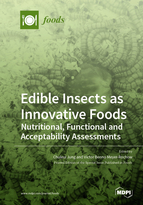Edible Insects as Innovative Foods: Nutritional, Functional and Acceptability Assessments
A special issue of Foods (ISSN 2304-8158). This special issue belongs to the section "Food Security and Sustainability".
Deadline for manuscript submissions: closed (30 May 2020) | Viewed by 126512
Special Issue Editors
Interests: insect ecology; honeybee biology; apiculture; edible insects; pollination biology; modeling
Special Issues, Collections and Topics in MDPI journals
Interests: neurobiology; sensory ecology; ethnobiology; entomophagy; bioluminescence; marine biology
Special Issues, Collections and Topics in MDPI journals
Special Issue Information
Dear Colleagues,
Will insects be the food of the future?
The answer is that we aren’t sure yet, but what we are certain of is that insects in the past were indeed a food item appreciated by humankind worldwide (Bequaert 1921, Bergier 1941; Bodenheimer 1951). Somehow and for reasons not completely understood, but probably related to the spread of Christianity that forbade the consumption of insects with the exception of four species of locust, the awareness that insects can be vectors of some fatal human diseases, the emotional separation from nature including entomophobia, and an increasingly greater variety of foodstuffs reaching the consumer, the use of insects as human food became less and less popular over the years.
However, there is no doubt that since time immemorial humans have almost certainly consumed some insects either by ingesting them more or less accidentally with fruit and other items or seeking to eat them deliberately. Even our closest animal relatives, the monkeys, have been observed to actively collect insects and other arthropods in order to eat them, e.g. Marshall 1902; Carpenter 1921; Nickle and Heymann 1996; Sanz et al. 2009) or, in the case of millipedes, to use them therapeutically (Weldon et al. 2003).
Over the last 30 years, there has been a renewed interest in insects as human food. International conferences have begun to focus more and more on edible insects since the XVI International Pacific Science Congress in Seoul in August 1987 and the International Conference on Minilivestock in Beijing in September 1995 brought this topic to a wider audience. Scientific publications, too numerous to mention, have appeared in the last 20 years or so, praising the advantages of an insect-based diet over a diet consisting of conventional meats like poultry and especially ruminants, and highlighting the environmentally advantageous farming of mini-livestock like insects over that of traditionally farmed animals. Various edible insect species have had their farming potential assessed, their acceptability as a novelty food (or feed in animal husbandry and fish culture) examined and their potential risk of carrying diseases or undesired microbes scrutinized.
Although insects should not be seen as a food item for humans merely to survive times of dietary hardship and periods of starvation, there is no way to deny that the global food security situation for the human population is becoming increasingly precarious and that food production worldwide has to increase by at least 50% to meet demand by 2050. Despite earlier reports of people who live traditionally in different parts of the world engaging in entomophagy (the consumption of insects), until Meyer-Rochow (1975) none of these reports had thought to link global food security to the universal and extensive use of insects as a possible and potent way to ease global food shortages.
We now possess a considerable amount of information on the kinds of insect that serve as food to various people in the world; we know that most insects are nutritious, consist of valuable protein, easily digestible fatty acids, and contain important minerals and vitamins, and recommendations exist regarding how to breed the most lucrative species optimally.
However, there are still gaps to be filled with regard to the processing of cultured insects, the preparation and conservation of insect-based foods, economics and marketing, and the potential of insects as suppliers of health-promoting drugs and medicines.
It is with these thoughts in mind that we accepted the task of serving as guest editors for this issue of the journal Foods on edible insects and their role as food as well as raw material for a variety of products.
Prof. Chuleui Jung
Prof. Victor Benno Meyer-Rochow
Guest Editors
Manuscript Submission Information
Manuscripts should be submitted online at www.mdpi.com by registering and logging in to this website. Once you are registered, click here to go to the submission form. Manuscripts can be submitted until the deadline. All submissions that pass pre-check are peer-reviewed. Accepted papers will be published continuously in the journal (as soon as accepted) and will be listed together on the special issue website. Research articles, review articles as well as short communications are invited. For planned papers, a title and short abstract (about 100 words) can be sent to the Editorial Office for announcement on this website.
Submitted manuscripts should not have been published previously, nor be under consideration for publication elsewhere (except conference proceedings papers). All manuscripts are thoroughly refereed through a single-blind peer-review process. A guide for authors and other relevant information for submission of manuscripts is available on the Instructions for Authors page. Foods is an international peer-reviewed open access semimonthly journal published by MDPI.
Please visit the Instructions for Authors page before submitting a manuscript. The Article Processing Charge (APC) for publication in this open access journal is 2900 CHF (Swiss Francs). Submitted papers should be well formatted and use good English. Authors may use MDPI's English editing service prior to publication or during author revisions.
Keywords
- entomophagy
- functionality
- preparation
- conservation
- economics
- marketing







